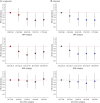Low Values for Blood Pressure, BMI, and Non-HDL Cholesterol and the Risk of Late-Life Dementia
- PMID: 35918162
- PMCID: PMC9559949
- DOI: 10.1212/WNL.0000000000200954
Low Values for Blood Pressure, BMI, and Non-HDL Cholesterol and the Risk of Late-Life Dementia
Abstract
Background and objectives: Low values of blood pressure, body mass index (BMI), and non-high-density lipoprotein (HDL) cholesterol have all been associated with increased dementia risk in late life, but whether these risk factors have an additive effect is unknown. This study assessed whether a combination of late-life low values for systolic blood pressure (SBP), BMI, and non-HDL cholesterol is associated with a higher dementia risk than individual low values of these risk factors.
Methods: This is a post hoc analysis based on an observational extended follow-up of the Prevention of Dementia by Intensive Vascular Care (preDIVA) trial, including community-dwelling individuals, aged 70-78 years and free from dementia at baseline. We assessed the association of baseline low values of SBP, BMI, and non-HDL cholesterol with incident dementia using Cox regression analyses. First, we assessed the respective associations between quintiles of each risk factor and dementia. Second, we explored whether combinations of low values for cardiovascular risk factors increased dementia risk, adjusted for interaction and potential confounders.
Results: During a median follow-up of 10.3 years (interquartile range 7.0-10.9 years), 308 of 2,789 participants (11.0%) developed dementia, and 793 (28.4%) died. For all risk factors, the lowest quintile was associated with the highest adjusted risk for dementia. Individuals with 1, 2, and 3 low values had adjusted HRs of 1.18 (95% CI 0.93-1.51), 1.28 (95% CI 0.85-1.93), and 4.02 (95% CI 2.04-7.93), respectively, compared with those without any low values. This effect was not driven by any specific combination of 2 risk factors and could not be explained by competing risk of death.
Discussion: Older individuals with low values for SBP, BMI, or non-HDL cholesterol have a higher dementia risk compared with individuals without any low values. Dementia risk was substantially higher in individuals with low values for all 3 risk factors than expected based on a dose-response relationship. This suggests the presence of an overarching phenomenon that involves multiple risk factors simultaneously, rather than resulting from independent effects of each individual risk factor.
Trial registration information: ISRCTN registry preDIVA: ISRCTN29711771. Date of study submission to ISRCTN registry: February 14, 2006. Recruitment start date: January 1, 2006. doi.org/10.1186/ISRCTN29711771.
Copyright © 2022 The Author(s). Published by Wolters Kluwer Health, Inc. on behalf of the American Academy of Neurology.
Figures


Similar articles
-
Adverse Lipid Profiles Are Associated with Lower Dementia Risk in Older People.J Am Med Dir Assoc. 2024 Sep;25(9):105132. doi: 10.1016/j.jamda.2024.105132. Epub 2024 Jul 6. J Am Med Dir Assoc. 2024. PMID: 38977201
-
Evaluation of the Concurrent Trajectories of Cardiometabolic Risk Factors in the 14 Years Before Dementia.JAMA Psychiatry. 2018 Oct 1;75(10):1033-1042. doi: 10.1001/jamapsychiatry.2018.2004. JAMA Psychiatry. 2018. PMID: 30043038 Free PMC article.
-
Modifiable dementia risk score to study heterogeneity in treatment effect of a dementia prevention trial: a post hoc analysis in the preDIVA trial using the LIBRA index.Alzheimers Res Ther. 2018 Jun 30;10(1):62. doi: 10.1186/s13195-018-0389-4. Alzheimers Res Ther. 2018. PMID: 29960597 Free PMC article.
-
Association and Interaction Analysis of Body Mass Index and Triglycerides Level with Blood Pressure in Elderly Individuals in China.Biomed Res Int. 2018 Nov 22;2018:8934534. doi: 10.1155/2018/8934534. eCollection 2018. Biomed Res Int. 2018. PMID: 30596101 Free PMC article.
-
Trajectory of blood pressure, body mass index, cholesterol and incident dementia: systematic review.Br J Psychiatry. 2020 Jan;216(1):16-28. doi: 10.1192/bjp.2019.156. Br J Psychiatry. 2020. PMID: 31368428
Cited by
-
Demographic and Clinical Characteristics Associated With Serum GFAP Levels in an Ethnically Diverse Cohort.Neurology. 2023 Oct 10;101(15):e1531-e1541. doi: 10.1212/WNL.0000000000207706. Neurology. 2023. PMID: 37813589 Free PMC article.
-
Association of adherence to the EAT-Lancet diet with risk of dementia according to social economic status: a prospective cohort in UK Biobank.Geroscience. 2025 Jun;47(3):3551-3564. doi: 10.1007/s11357-024-01333-7. Epub 2024 Sep 12. Geroscience. 2025. PMID: 39264406 Free PMC article.
-
Evidence from NHANES 2011-2014: a correlation between the weight-adjusted-waist index and cognitive abilities in the United States.Front Aging Neurosci. 2025 Jan 30;17:1480609. doi: 10.3389/fnagi.2025.1480609. eCollection 2025. Front Aging Neurosci. 2025. PMID: 39949539 Free PMC article.
-
Year-by-Year Blood Pressure Variability From Midlife to Death and Lifetime Dementia Risk.JAMA Netw Open. 2023 Oct 2;6(10):e2340249. doi: 10.1001/jamanetworkopen.2023.40249. JAMA Netw Open. 2023. PMID: 37902753 Free PMC article.
-
Lipoprotein levels and statin treatment related to dementia and cognitive decline in individuals with type 2 diabetes: an observational analysis from the ADVANCE study.Cardiovasc Diabetol. 2025 Aug 18;24(1):340. doi: 10.1186/s12933-025-02894-3. Cardiovasc Diabetol. 2025. PMID: 40826451 Free PMC article.
References
-
- Norton S, Matthews FE, Barnes DE, Yaffe K, Brayne C. Potential for primary prevention of Alzheimer's disease: an analysis of population-based data. Lancet Neurol. 2014;13(8):788-794. - PubMed
-
- Qiu C, Winblad B, Fratiglioni L. The age-dependent relation of blood pressure to cognitive function and dementia. Lancet Neurol. 2005;4(8):487-499. - PubMed
-
- Mielke MM, Zandi PP, Sjogren M, et al. . High total cholesterol levels in late life associated with a reduced risk of dementia. Neurology. 2005;64(10):1689-1695. - PubMed
Publication types
MeSH terms
Substances
Associated data
LinkOut - more resources
Full Text Sources
Medical
